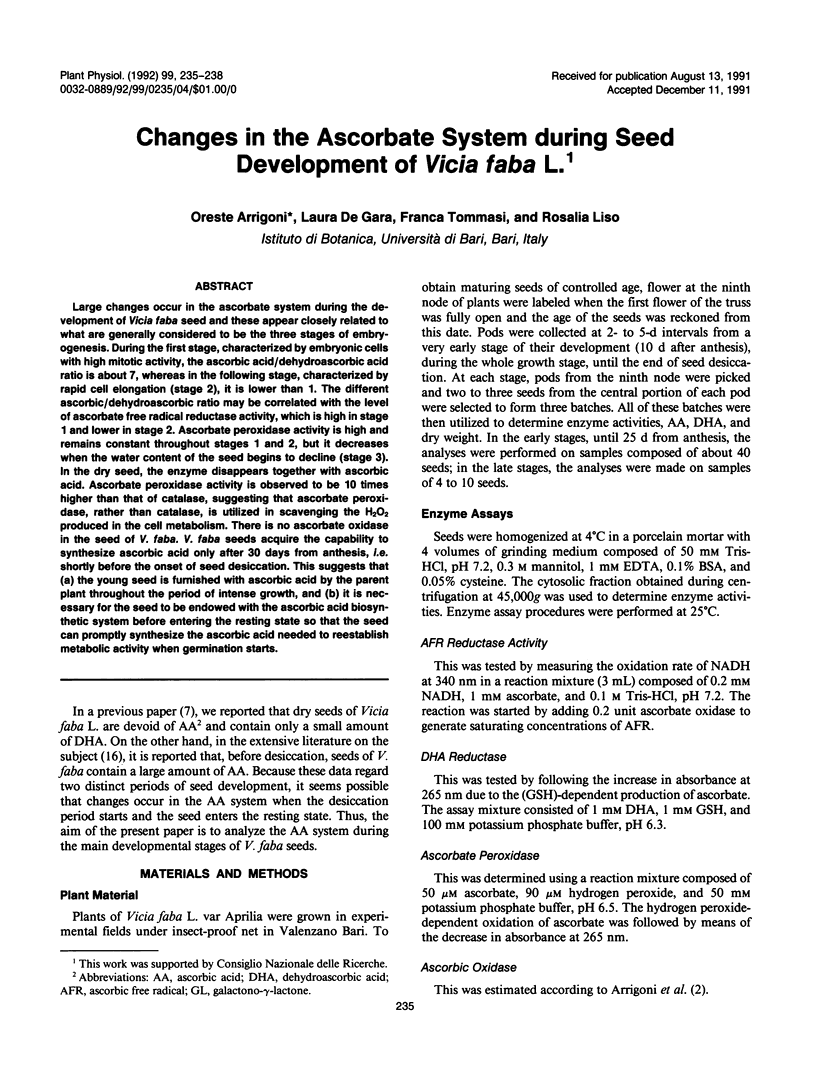Abstract
Large changes occur in the ascorbate system during the development of Vicia faba seed and these appear closely related to what are generally considered to be the three stages of embryogenesis. During the first stage, characterized by embryonic cells with high mitotic activity, the ascorbic acid/dehydroascorbic acid ratio is about 7, whereas in the following stage, characterized by rapid cell elongation (stage 2), it is lower than 1. The different ascorbic/dehydroascorbic ratio may be correlated with the level of ascorbate free radical reductase activity, which is high in stage 1 and lower in stage 2. Ascorbate peroxidase activity is high and remains constant throughout stages 1 and 2, but it decreases when the water content of the seed begins to decline (stage 3). In the dry seed, the enzyme disappears together with ascorbic acid. Ascorbate peroxidase activity is observed to be 10 times higher than that of catalase, suggesting that ascorbate peroxidase, rather than catalase, is utilized in scavenging the H2O2 produced in the cell metabolism. There is no ascorbate oxidase in the seed of V. faba. V. faba seeds acquire the capability to synthesize ascorbic acid only after 30 days from anthesis, i.e. shortly before the onset of seed desiccation. This suggests that (a) the young seed is furnished with ascorbic acid by the parent plant throughout the period of intense growth, and (b) it is necessary for the seed to be endowed with the ascorbic acid biosynthetic system before entering the resting state so that the seed can promptly synthesize the ascorbic acid needed to reestablish metabolic activity when germination starts.
Full text
PDF



Selected References
These references are in PubMed. This may not be the complete list of references from this article.
- BEERS R. F., Jr, SIZER I. W. A spectrophotometric method for measuring the breakdown of hydrogen peroxide by catalase. J Biol Chem. 1952 Mar;195(1):133–140. [PubMed] [Google Scholar]
- Dalton D. A., Hanus F. J., Russell S. A., Evans H. J. Purification, properties, and distribution of ascorbate peroxidase in legume root nodules. Plant Physiol. 1987 Apr;83(4):789–794. doi: 10.1104/pp.83.4.789. [DOI] [PMC free article] [PubMed] [Google Scholar]
- De Gara L., Tommasi F. Further researches upon the inhibiting action of lycorine on ascorbic acid biosynthesis. Boll Soc Ital Biol Sper. 1990 Oct;66(10):953–960. [PubMed] [Google Scholar]
- De Gara L., Tommasi F., Liso R., Arrigoni O. Il sistema dell'acido ascorbico in Vicia faba L. Boll Soc Ital Biol Sper. 1987 Jun 30;63(6):551–558. [PubMed] [Google Scholar]
- Groden D., Beck E. H2O2 destruction by ascorbate-dependent systems from chloroplasts. Biochim Biophys Acta. 1979 Jun 5;546(3):426–435. doi: 10.1016/0005-2728(79)90078-1. [DOI] [PubMed] [Google Scholar]
- Lamport D. T. The isolation and partial characterization of hydroxyproline-rich glycopeptides obtained by enzymic degradation of primary cell walls. Biochemistry. 1969 Mar;8(3):1155–1163. doi: 10.1021/bi00831a049. [DOI] [PubMed] [Google Scholar]
- MAPSON L. W., ISHERWOOD F. A., CHEN Y. T. Biological synthesis of L-ascorbic acid: the conversion of L-galactono-gamma-lactone into L-ascorbic acid by plant mitochondria. Biochem J. 1954 Jan;56(1):21–28. doi: 10.1042/bj0560021. [DOI] [PMC free article] [PubMed] [Google Scholar]
- Shigeoka S., Nakano Y., Kitaoka S. Purification and some properties of L-ascorbic-acid-specific peroxidase in Euglena gracilis Z. Arch Biochem Biophys. 1980 Apr 15;201(1):121–127. doi: 10.1016/0003-9861(80)90495-6. [DOI] [PubMed] [Google Scholar]
- Tommasi F., De Gara L. Correlazione tra presenza di acido ascorbico e comparsa dell'attivita' ascorbico perossidasica in embrioni di Avena sativa L. Boll Soc Ital Biol Sper. 1990 Apr;66(4):357–364. [PubMed] [Google Scholar]
- Tommasi F., De Gara L., Liso R., Arrigoni O. Presenza di ascorbico perossidasi nel regno vegetale. Boll Soc Ital Biol Sper. 1987 Sep 30;63(9):779–786. [PubMed] [Google Scholar]
- YAMAZAKI I., PIETTE L. H. Mechanism of free radical formation and disappearance during the ascorbic acid oxidase and peroxidase reactions. Biochim Biophys Acta. 1961 Jun 10;50:62–69. doi: 10.1016/0006-3002(61)91060-5. [DOI] [PubMed] [Google Scholar]


